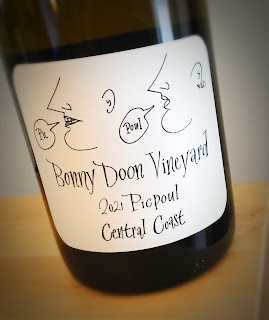The imaginary Bonny Doon timeline stretches from a 1954 decree in Chateauneuf-du-Pape, which banned aliens from landing their flying cigars in vineyards, to 1986 when
Bonny Doon Vineyard released their Le Cigare Volant wine, and on to today when the stripped-down Dooniverse includes a wine made with the Picpoul grape.
It was Randall Grahm's decision to move from trying to make Burgundian wines in sunny California to giving the Rhône a go. It worked. His little winery that could, did. He became the Rhône Ranger. The winery became huge, he became disillusioned and sold off parts of it over the past couple of decades.
His mood can lift, though, with the release of a fantastic expression of Picpoul, which means "lip stinger" en Francais. It is a much-loved grape in the south of France, carrying a brisk acidity, dancing light on its feet and providing an ultra savory accompaniment to food, according to Grahm.
More closely aligned with France's Languedoc region, the Picpoul Blanc grape has taken root in California's Monterey and Sonoma counties, as well as in places like Texas, Arizona and Washington state.
Bonny Doon's 2021 Picpoul is 90% Picpoul and 10% Grenache Blanc, mostly from the Beeswax Vineyard in Arroyo Seco with support from the Nolan Vineyard in Santa Barbara County.
Grahm says the Beeswax Vineyard produces white grapes which have the scent of "well… beeswax," white flowers and pineapple. He credits the wine's "bracing acidity," savoriness and a bit of brininess for its easy pairing with crabs, lobster, oysters and the like. Alcohol is a minimalist 11% abv.
Wendy Cook drew the label art, which shows the French pronunciation of the grape's name and a visual description of the way it translates.
This white wine is bright, savory and full of acidity - ready for pairing with your favorite seafood. The winemaker speaks of its brininess, which I get as a bit of seashore, much as in Vermentino. There is a floral aspect, but the primary focus is on minerals and salinity. It is a fantastic white, perfect for the coming warmer months and just as good until then.
In addition to the wine, I received a cardboard standup of the Bonny Doon alien, who may have touched down in the Beeswax Vineyard, since there is no decree banning the practice in California. It now lives at my home until the property management suits come nosing around.
Follow Randy Fuller on Twitter














